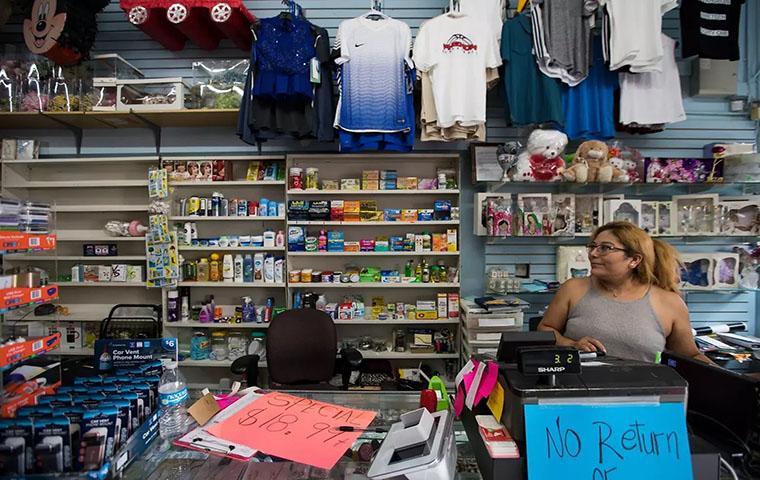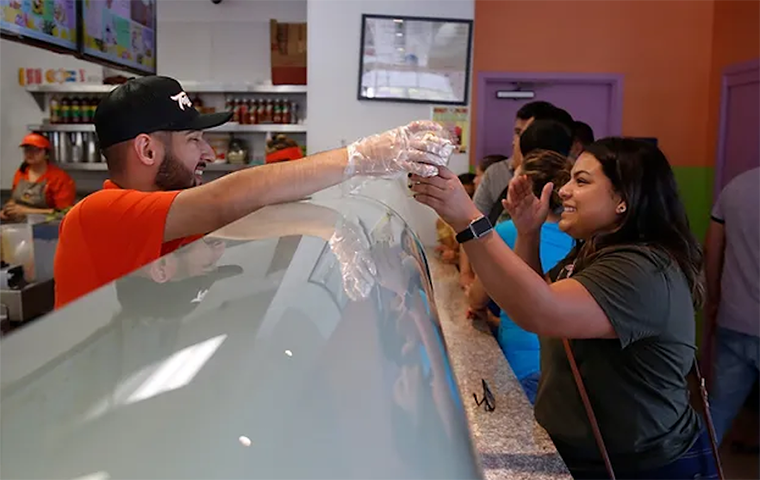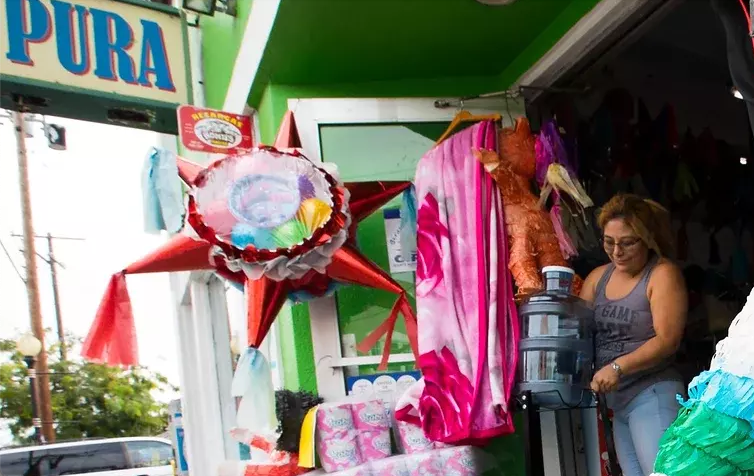
The Power of Words
Students in Senior Lecturer Barbara Kelley’s Advanced Journalism class told the stories of Calle Willow as residents and business owners fought to stay in the historic district.
In San Jose’s Calle Willow district, a vibrant, close-knit community south of downtown, you’ll find brightly-colored storefronts painted lime green, orange, and yellow, a panaderÍa selling fresh sweet bread and coffee, craft makers and party suppliers showcasing piñatas and traditional Mexican dresses.
Though vibrant today, this small, largely Latinx community was at risk just last year. With a massive Google campus slated to open in roughly 10 years, city officials sought to re-zone Calle Willow. This initiative would make way for upscale businesses and residential properties to cater to the influx of 20,000 tech employees, but it would come at a cost, specifically, the rich cultural community that lives there currently.
Fearing they would be priced out of the area they’ve lived and worked in for decades, Calle Willow residents and business owners mobilized to fight for their community, expressing their frustration at protests and government meetings.
Always one to challenge her students with ambitious assignments, Senior Lecturer Barbara Kelley asked students in her Advanced Journalism class to help. By telling the stories of Calle Willow, they could highlight the impact of the potential displacement on the cultural fabric of San Jose and, more broadly, what gentrification has done to many underprivileged communities across the U.S.
“We wanted voters to be informed about the impact that re-zoning would have on the people of Calle Willow,” said Karina Gonzalez-Lopez ’22.
The class, which fulfills Santa Clara’s Experiential Learning for Social Justice (ELSJ) requirement, immerses students in local communities through a news reporting lens. In recent years, Kelley’s students worked with San Jose’s immigrant communities with the help of the Ignatian Center. Last year, the class collaborated with organizers at Sacred Heart Community Services, which provides critical support to community members in San Jose and advocates for justice.

Martha's Kitchen in Calle Willow
Paulina Gonzalez-Bello ’22 and her group packaged their stories into “Humans of Calle Willow,” a play on the popular platform, “Humans of New York,” which features tragic, quirky, and fun, bite-sized stories from strangers in New York.
Gonzalez-Bello focused on Gabriela Moralez—who was given a pseudonym for the project to protect her anonymity—who owns the clothing and party supply store, Decoraciones Esbeidy with her family. Intricate quinceañera gowns and tuxedos fill the store, and shoes, jewelry, and other knickknacks line the shelves of the small business.
Moralez lives in a three-bedroom home nearby with her parents, husband, and two children. Her mother cooks dinner for the entire family, and her father tends to the yard that her children love to play in. On Sundays, they attend mass at Sacred Heart parish down the street.
Moralez recalled feeling like an outsider when she first immigrated to San Jose from Mexico as a teen, overwhelmed by the language barrier and the significant cultural shift. Calle Willow has always been the one place she felt at home, she told Gonzalez-Bello. But through the years, she has seen many family members and friends get pushed out by skyrocketing rents.
“She told me, ‘I don’t know, what’s going to happen to my kids, I don’t know, where we’re going to live with my parents,’” recalled Gonzalez-Bello. “The family has had its business for like 10-plus years. It’s their livelihood. If they take that away, they have nothing.”
As the only Spanish speaker in her group, Gonzalez-Bello ’22 often led interviews with community members. It was difficult to build connections with strangers at first, she says, but as she spent more time in Calle Willow, frequenting the eateries and striking up conversations with familiar faces, connections blossomed organically.
“We would talk to a person one week and then come back and talk to them again,” says Gonzalez-Bello. “We would hear their stories and see that most of these people have lived there for years—literally more than 20 years. They have built their whole lives there. You see how much they love this place.”
Kelley said she wanted her students to witness the power they have as journalists, and encouraged them to tell stories that showed readers and city officials what was at stake in losing Calle Willow.
Students were required to put in 16 hours of ELSJ engagement. But unlike most ELSJ classes, the project had no set schedule, and it was up to students to map out their time. Some of those hours were spent on Zoom with community organizers or in planning commission meetings. Students also spent several days in the neighborhood, talking to whoever was willing to spend time with them.
Their projects took on many forms: some wrote articles and essays, while one group designed a website featuring photos and reports from Calle Willow. Another told stories through everyday images: handmade bracelets, Tacquerias, Arreola’s beauty salon, a clothing display outside La Bonita Flowers.
One student featured the manager at Metro Balderas, a taco shop on Willow and Locust Streets who feared the small shop would be bought out by Google. That would’ve meant the loss of a small Latinx business, and employees losing their jobs. She worried the same would happen with many other businesses in the district.
The owner of La Mejor Taqueria 2 echoed those concerns. “This would put bigger companies and people with more money in these places,” she said. “We can’t afford a new building or higher rent. Our business would be jeopardized by that.”
The overarching idea, says Kelley, was that in the real world, activists and residents would bring these news pieces to city council meetings or planning commission meetings and say, ‘This is what we lose if Calle Willow disappears.’”
“I hope there was at least a visceral sense that they were part of an important process,” says Kelley.
In the end, the San Jose City Council voted in December to remove Calle Willow from the city’s rezoning plan. The businesses and community are safe for now, but with gentrification a constant problem in the Bay Area, the skills these students learned will continue to come in handy.
Gonzalez-Lopez, who grew up in Watsonville, said this situation felt personal to her. Her hometown of Watsonville is quickly becoming a tourist destination which means her community is being priced out.
“Doing this project felt like I was also learning more about my own community in a sense, and about how I can potentially bring more awareness to the issue because it’s not very known.”
Gonzalez-Lopez said the project became even more meaningful when students saw that stories like theirs could potentially influence the outcome of important decisions.
“Knowing that with our privileges as journalism students at Santa Clara, we can bring awareness to a topic like this, it felt very rewarding at the end,” said Gonzalez-Lopez.
